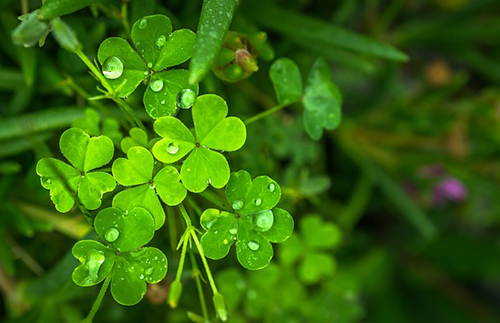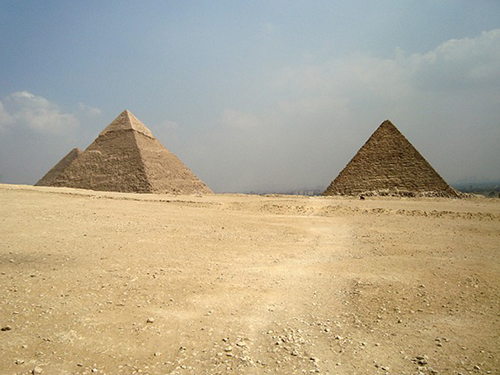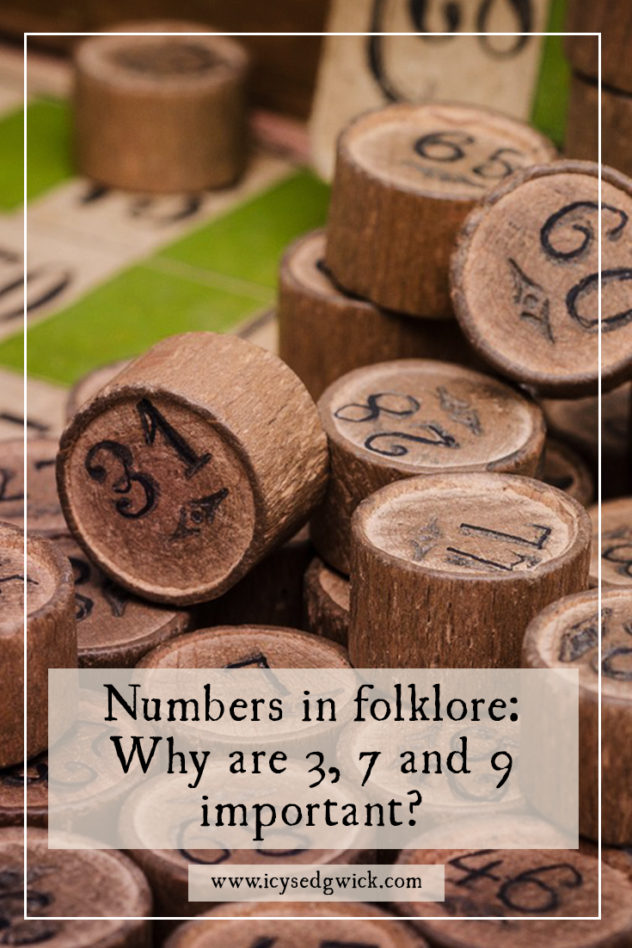When you think of fairy tales, you’ll often notice patterns in the numbers that appear. Think of the three bears, the seven dwarves, or seven-league boots. Numbers in folklore become an important way to navigate the stories.
Many of these tales derive from much older versions. And it seems ancient people loved numbers.
In the 6th Century BCE, the Greek Pythagoreans founded a system based on numerology (Encyclopedia69 2009). For them, the first 9 numbers held sacred meanings.

3 represented Harmony since 1 meant Unity, and 2 meant Disorder. Add the two together and you reach a harmonious conclusion. 9 represented Triple Perfection – or Harmony x 3.
It wasn’t just the ancient Greeks that developed such systems. Numerology also appears in ancient Babylon and Egypt, the Indus Valley, and even South America.
But numerology and other numbers in folklore are a massive topic. So we’re going to narrow the focus and look at three of the most common ‘magic numbers’ in folklore. Let’s look at the numbers 3, 7, and 9 …
Three’s a Crowd
Many things in the world of folklore come in groups of three. Think of the Three Bears. Or the Three Billy Goats. And there’s the little mermaid, who needs to secure the love of her prince before sunset on her third day as a human.
Some superstitions rely on ‘third time lucky’. In Germany, people made paper triangles, adding a cross to each corner. Prayers were written in the middle. They protected cradles from witches. Somehow, they also guarded against gout.

Alonna Liabenow points out that the tasks set in fairy tales either need to be completed in three days or they come in groups of three (2014: 3). Liabenow theorises that these ‘three-day’ periods could refer to a range of Biblical triads. Jesus was resurrected after three days, Peter denied he knew Jesus three times, and the three times Jesus speaks on the cross before he dies (2014: 4-6). (Remember the Three Wise Men, too).
Characters also sometimes come in threes, like Cinderella and her two stepsisters. The Slavic witch Baba Yaga has three horsemen, representing Day, the Sun, and Night. Think of the three witches of Macbeth.
But how often do you hear people say bad things always happen in threes? Perhaps humans use the number three as a way to draw a line under misfortune.
There is a superstition that you should never light three cigarettes with the same match or it will lead to death. I did read an explanation of this from the trenches of the First World War. The first match alerts a sniper to your location, the second lets him take aim, and he fires by the third.
3 in the Ancient World
Christianity has the Father, the Son, and the Holy Spirit. Christ apparently died at 3 pm. That partially explains why many believe 3 am to mark the start of the Devil’s Hour.

The Egyptian pantheon hosts the earlier Trinity of Osiris, Isis, and Horus. In Norse mythology, Odin, Thor, Freyr and Freyja all have three weapons, artefacts or magical items. There are three realms – Nilfhelm, Midgard, and Asgard. Three cockerels herald the start of Ragnarök. There are three Norns.
And Greek mythology gets in on the act. The three brothers, Zeus (the sky), Poseidon (the seas), and Hades (the underworld), divide up the world between them. The Three Fates, Clotho, Lachesis, and Atropos, govern the length of a human life.
But why ‘3’ at all?
Why three? It’s an important number because it disrupts the binary of two. It creates a ‘middle’ between left and right. Imagine the three Fates of Greek mythology. When they represent Birth, Life Span, and Death, which could you remove to safely leave two? Three creates the beginning of a spectrum, which allows for evolution and difference to emerge.

In the tarot, the threes represent creation. You put the first two together, and create a third (think of parents and their first child). Or you can think of it as evolution. Develop a third corner to your argument (again, avoid the binary). This gives you a triangle, one of the strongest structures available.
K. Sean Buvala gives a plausible reason for the use of the number 3. When two people attempt a task and fail, that gives the third person to attempt a better chance (2017). After all, they’ve had the opportunity to watch what the first two did wrong. They can repeat the things they did right and avoid the things they did wrong.
Or think of the Rule of Thirds in art and photography. Images that follow the Rule (demonstrated below) are naturally more harmonious than those that don’t.

Even three organs hide inside the brain: the pineal and pituitary glands, and the central thalamus.
Maybe the human brain finds harmony in the number three after all.
The Seventh son of the Seventh son
It’s not just Iron Maiden who understood the importance of the numbers in folklore. In Ireland, the seventh son of the seventh son possessed magical abilities. Thomas the Rhymer remained in Faerie for seven years and gained the magical gift of prophecy.
Annemarie Schimmel conducts a survey of the number seven, and finds it appears in a whole host of civilisations throughout the ages. She also notes the seven stars of the constellation Pleiades, the original seven planets of the solar system, and a host of ‘sevens’ in the Bible (1993: 131). We have seven virtues and seven deadly sins. Schimmel even refers to seven “[a]s the number of perfection” (1993: 135). Like three, seven is a prime number, divisible only by itself and one.
The cult of Mithras is believed to have seven degrees of initiation. Schimmel notes this may have fed ideas around the Christian model of the seven layers of purgatory (1993: 143).

But think of the famous saying – seven years of bad luck for breaking a mirror. This comes from a Roman belief in the renewability of the human soul every seven years.
Mystical Seven
Some scholars believe the mystical power of seven derives from the chakra system. Humans have seven major energy centres, corresponding to the seven levels of consciousness. If you blend the seven colours of the rainbow, you get white.
Other religions also place a lot of importance on the number seven. Catholicism has the 7 Sacraments. And Islam also has 7 Pillars.
In the tarot, the sevens refer to challenges. They’re not outright conflicts like the fives, but they’re an opportunity to use creativity and innovation to solve a problem. There’s a lot of determination required to overcome these challenges.
But why ‘seven’?
We’re used to the number in our daily lives. Seven days make up a week. The rainbow boasts seven visible colours. We’ve heard of the seven wonders of the ancient world. And there are seven notes in a musical scale (the eighth forms the octave and harmony).

Now, granted, many of these ‘sevens’ could come from human concepts, such as the division of time. Yet I think the number is important because of its mystical associations.
Some believe seven is so powerful because it represents the sum of the spiritual (3) and material (4) realms.
This belief then bleeds into the folktales. The characters stand in for these ‘seven’ values. Though I’ll leave it up to you to decide which of the seven virtues the seven dwarves represent.
And the number 9!
Nine is a very lucky number since it’s 3 x 3…or the Trinity tripled.

Why else do you think we’re on cloud nine after a good day? (Which is especially confusing since we’re described as being in seventh heaven). Cats, one of the more supernaturally associated animals, enjoy nine lives.
It’s difficult to pinpoint exactly where this phrase came from. Some think it comes from an old English proverb: “A cat has nine lives. For three he plays, for three he strays, and for the last three he stays”. This is believed to refer to a cat’s lifespan as a kitten, an adult cat, and an elderly cat.
Others think it comes from Romeo and Juliet, where Tybalt exclaims “Good king of cats, nothing but one of your nine lives”. Another internet myth is that it derives from ancient Egypt. The truth is, no one knows.
You’ll find many internet articles trying to link the holiness of 9 in many religions with cats and their lives. Trouble is, not every culture has the association. And not every culture is predisposed to think well of cats.
Anatoly Liberman relates a custom of lovers to break a nine-pence coin in two. Each partner kept their half in order to reunite them when they next met up (2019).

This custom lives on in the matching ‘half coin’ necklaces found in many mass-market jewellery stores.
Nine for the Ancients
The number 9 was also important in the Norse worldview. While we earlier mentioned three realms, Yggdrasil supports nine worlds. It took Hermod nine nights to try and free Baldr from Nilfheim. Odin hung upon Yggdrasil for nine days and nights (and was rewarded with the runes).
Nine appears in Greek myth. There were nine Muses. And the River Styx flowed around nine twists.

In the tarot, the nines refer to a sense of completion. We’re not entirely at the destination yet (that’s the Ten). Instead, we’re at the point where we’re checking we’ve dotted all the i’s and crossed all the t’s. It’s the opportunity to integrate all that we’ve learned so far.
The Unlucky Side of Nine
In medieval Germany, people believed you could enter the world of Faerie by twirling nine times (Encyclopedia 69 2009)! If you want to enter a fairy ring but don’t want to enter the world of Faerie? Run around the ring nine times first (Leafloor 2018).
But the number nine isn’t quite so lucky in Japan. Said aloud, the number sounds similar to the word for torture (Turner 2020).
16th-century theologian Peter Bungus realised the Ninth Psalm predicts the rise of the Antichrist. So perhaps nine is less lucky than it appears. I’m sure a cat on their ninth life might agree.
So why do numbers in folklore hold such power?
Numbers are a fascinating part of our lived experience. They allow us to gauge how much (or little) we have of something. It gives us a way to measure our environment, even in a small way. When you measure a thing, you can control it.
The ancient Greeks, Hebrews and Chaldeans practised a form of divination with numbers called arithmomancy (also arithmancy). It was their way of seeking to better understand the universe. Numbers are assigned to the letters of the alphabet. A common rule equates A with 1, B with 2, and so on.

Add up each of the numbers according to the letters in a name. Keep adding them together until you get a single digit. The numbers that come from these names can then tell you about the person’s finances, and health, and so on.
So my real name adds up to 189. I’ll be honest, I’m not sure of the significance. I can add them together and get 18, and then 9. Which is kind of cool, I guess?
As to why 3, 7 and 9 are important, they’re all odd numbers. According to Bambi Turner, even numbers are considered unlucky and odd numbers are lucky. Perhaps this is due to the fact odd numbers can’t be halved (2020). In the case of 3 and 7, they’re also prime numbers – so only divisible by themselves and one. Maybe this lends them a magical air.
But numbers also leads to counting!
I even found some cool superstitions about counting itself! If you have warts, count how many you have. Tell that number to a stranger and they’ll go away.
Apparently counting possessions, money and even children can also cast them away as well (Turner 2020). So be careful when you’re writing your insurance manifests.
And if the power of numbers interests you, I have a tale about numbers in my free short story collection below. It asks the question; what if numbers hold the universe together?
Download your copy and find out!
References
Buvala, K. Sean (2017), ‘Two Plus One is Greater than Three: The Presence of the Number 3 in Fairytales and Folklore’, Storyteller.net, http://storyteller.net/two-plus-one-is-greater-than-three-the-presence-of-the-number-3-in-fairytales-and-folklore/.
Encyclopedia 69 (2009), ‘Magic Numbers’, Encyclopedia 69, http://www.encyclopedia69.com/eng/d/magic-numbers/magic-numbers.htm.
Leafloor, Liz (2018), ‘Do you dare enter a fairy ring? The mythical mushroom portals of the supernatural’, Ancient Origins, https://www.ancient-origins.net/human-origins-folklore/do-you-dare-enter-fairy-ring-mythical-mushroom-portals-supernatural-003677.
Liabenow, Alonna (2014), “The Significance of the Numbers Three, Four, and Seven in Fairy Tales, Folklore, and Mythology”, Honors Projects, 418, http://scholarworks.gvsu.edu/honorsprojects/418.
Liberman, Anatoly (2019), ‘Numerals, especially the number nine, in folklore and language’, Oxford University Press blog, https://blog.oup.com/2019/06/number-nine-numerals-folklore-language/.
Schimmel, Annemarie (1993), The Mystery of Numbers, Oxford: Oxford University Press.
Turner, Bambi (2020), ’13 Superstitions About Numbers’, How Stuff Works, https://people.howstuffworks.com/13-superstitions-about-numbers.htm.
Ghosts & goddesses

Would you like more folklore and weird tales? Add your email to get them once a month, and receive this free copy of my short story collection too!








This was so interesting, Icy. I didn’t know about a lot of it!
What’s your favourite number?
9. I like to add up all of the individual numbers in any number that has two or more digits. For example, 144 would be 1+4+4=9.
9 is the biggest number you can get with this method. For some strange reason, that makes me happy. 🙂
Hehe awesome!
My daughter was born 6/22/05 ; added together (6+22+05) you get a total of 33. My son was born 6/6/13 ; added together (6+6+13) you get a total of 25. I was 25 when my daughter was born and 33 when my son was born…… Woah. And just for fun…. My birthday 8/23/80 equals 111!
Very interesting for some late night reading 🙂 thank you. I find numerology very fascinating!
Glad you enjoyed it!
My Blessed numbers are 3 ,4, 7 ,6 ,12 explain: I was born on 12-3-66, We are 7 siblings and I have 7 children. I have 3sons and 4daughters, my husband was born 3-23-50 My Grandson was born 3-27-2016, I came to United States 43 years later. My numbers are very Biblical to note Genesis,exodus spoke about it. Thanks Just sharing
I’m still looking for my lucky numbers. I’ve tried all kind of Lottery combinations, but none of them have come up yet :(.
I like the way your wording shares the folklore, but the scientific methods such as that of archaeology do tell a more accurate state of origin behind the numbers, and how they became folklore. Nevertheless, your way of sharing it does spark a blogging.
Ooh if you have time, would you be able to point me in the direction of some sources?
Great article! Writing a novel with background cosmology, etc… Not to distract from the article, but thought you should know that the alarm clock picture in the article is set to 12:15 not 3:00.
The photo is for illustrative purposes because I couldn’t find a stock photo for 3 o’clock.